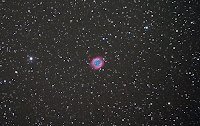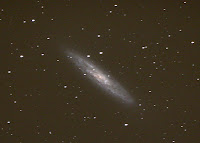Way back when I first moved to Arizona back in '79, I actually worked and lived at Kitt Peak National Observatory (KPNO), about a 55 mile drive to the southwest of Tucson. It was a dream job - rubbing elbows every day with astronomers at the forefront of the field, using some of the largest telescopes in the world at a fantastic mountaintop location. I lasted over 5 years before deciding to pursue a living in optics, but KPNO was and still is, a magical place for me.

By living on the mountain, I worked and breathed telescopes and astronomy. I was an avid photographer and I was often out roaming at night with camera and tripod. Though I didn't need much motivation, KPNO also published a few calendars in the early 80s, and were always looking for new shots for them and postcards for the visitor center.
One of my favorites is shown at left - a 45 minute exposure from about 28 years ago back in the 35mm film days. Camera and tripod were set up at a pullout at milepost 11. After starting the exposure, I drove the little jeep we used to drive the mile up the road and used the tail lights to "paint" the 4-Meter dome at left. It enjoyed a short life as a postcard in the visitor center, and I never got the original back, though I did get 50 free postcards! I occasionally still see it (most recently about 5-6 years ago) in astronomy calendars!
Latest Update: The NOAO Public Information Office located my image and supplied me with the high resolution scan shown here. Thanks Guys! And by the way, everyone I've heard express an opinion prefers this 25-year-old image to the newer ones below... What the heck do they know?! !

Fast forward to 2005. After a major heart surgery, when it was apparent I was going to survive, I got one of them newfangled digital SLRs, and one of my first trips up to Kitt Peak in January of 2006, image #482 is shown here. This one is a 2 minute exposure with a fast lens (85mm F/2) from the same location. It became another favorite of mine, and still serves as the background image for my laptop computer since taking it almost 6 years ago. Clicking and saving the image loads a size that should work for you if you are interested...

As nice as that image is, it was a little short in my opinion because it missed that little framing glow around the base of the telescope. So this last Saturday I parked again at the mile post 11 pullout (in the very spot where 5 weeks ago Melinda and I saw a largish mountain lion leave the road as our headlights approached!) to take a few more images. Fortunately I was able to catch a car circle the telescope to catch a little highlight glow. I like it a little better than the 2006 image - but I'm always wondering how I can make it better... Suggestions?
 I've been taking pictures of the sky for decades now, and I end up learning something new every time I'm under a dark sky. Mostly one learns by making mistakes - taking what you thought was a 30 minute exposure, but the shutter was set to 1/500 second, leaving on the lens cap, standard stuff like that. It is easier now with the instant feedback of the digital cameras, but you can still have issues with weather, telescopes and equipment. Case in point was from one of my last times out - in the middle of a sequence on the Helix Nebula (a large, bright planetary nebula in Aquarius), my CamTrack unexpectedly stopped in mid-exposure for a minute, then restarted. While the left image here shows a stacked set of 12 exposures, the right one shows the trailed one. But even it has an unexpected appearance. The tracked image sections were nearly identical - reminding me of a pair of eyeballs, not unlike a current ad campaign for Geico Insurance!
I've been taking pictures of the sky for decades now, and I end up learning something new every time I'm under a dark sky. Mostly one learns by making mistakes - taking what you thought was a 30 minute exposure, but the shutter was set to 1/500 second, leaving on the lens cap, standard stuff like that. It is easier now with the instant feedback of the digital cameras, but you can still have issues with weather, telescopes and equipment. Case in point was from one of my last times out - in the middle of a sequence on the Helix Nebula (a large, bright planetary nebula in Aquarius), my CamTrack unexpectedly stopped in mid-exposure for a minute, then restarted. While the left image here shows a stacked set of 12 exposures, the right one shows the trailed one. But even it has an unexpected appearance. The tracked image sections were nearly identical - reminding me of a pair of eyeballs, not unlike a current ad campaign for Geico Insurance! Another example is a shot of the local group galaxy NGC 253, a mere 12 million light years away. It is a fine, bright galaxy, easily visible in binoculars, though low in the sky and tough to spot from the Midwest. In an effort to image it my last observing session, after spending a couple hours to setup the 14" Celestron and mount, install the Hyperstar optics, align and focus, I realized it was just too windy to get good exposures, even at 90 seconds of exposure. The blustery wind gusts, just made it impossible to keep the guide star on the cross hairs, so I gave up the idea of using the moderately long focal length of the C14 + Hyperstar that night. And while it looks ok as a thumbnail, looking at even a moderate scale shows icky images...
Another example is a shot of the local group galaxy NGC 253, a mere 12 million light years away. It is a fine, bright galaxy, easily visible in binoculars, though low in the sky and tough to spot from the Midwest. In an effort to image it my last observing session, after spending a couple hours to setup the 14" Celestron and mount, install the Hyperstar optics, align and focus, I realized it was just too windy to get good exposures, even at 90 seconds of exposure. The blustery wind gusts, just made it impossible to keep the guide star on the cross hairs, so I gave up the idea of using the moderately long focal length of the C14 + Hyperstar that night. And while it looks ok as a thumbnail, looking at even a moderate scale shows icky images... So what do you shoot on a perfectly clear but windy night? Well, the CamTrack looked stable enough, so I mounted up a wide-angle lens and shot a half dozen frames of the Gegenshein. I file this object under the "frequently observed but rarely noticed" category. It is up most every night, but you really have to look for it from a dark site to see it, but really is visible most every night. It is the reflection of sunlight from interplanetary dust in the solar system and always appears opposite the sun, so is at it's highest at midnight. In this exposure, 18 minutes of exposure with the 10-22mm zoom set to the widest view shows the sky from Jupiter to Taurus and also shows the Andromeda and Triangulum galaxies and a host of other fainter sky objects. The diffuse elongated glow along the line from Jupiter to the Pleiades is part of the zodiacal band and Gegenshein. Even observing buddy Christian, an advanced European observer had never noticed/seen it before, so I was able to provide a first for him...
So what do you shoot on a perfectly clear but windy night? Well, the CamTrack looked stable enough, so I mounted up a wide-angle lens and shot a half dozen frames of the Gegenshein. I file this object under the "frequently observed but rarely noticed" category. It is up most every night, but you really have to look for it from a dark site to see it, but really is visible most every night. It is the reflection of sunlight from interplanetary dust in the solar system and always appears opposite the sun, so is at it's highest at midnight. In this exposure, 18 minutes of exposure with the 10-22mm zoom set to the widest view shows the sky from Jupiter to Taurus and also shows the Andromeda and Triangulum galaxies and a host of other fainter sky objects. The diffuse elongated glow along the line from Jupiter to the Pleiades is part of the zodiacal band and Gegenshein. Even observing buddy Christian, an advanced European observer had never noticed/seen it before, so I was able to provide a first for him...










































